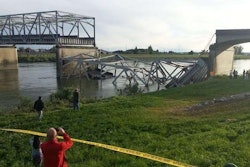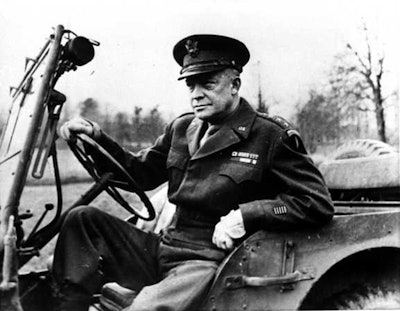
The trouble with most management and leadership books crowding the shelves today is that many of them were written by people who’ve never managed anything bigger than their own publishing enterprises. I prefer biographies. And one of the best biographies I’ve read in many years is Eisenhower: In War and Peace, by Jean Edward Smith.
So what can construction company owners and executives learn from reading about Eisenhower? Plenty. Here are 10 key lessons:
1. Physical fitness helps you survive.
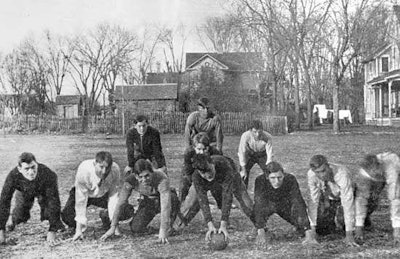
Mental stress eventually takes a toll on your body. The tension and pressure, the 18 hour days and responsibilities of planning for D-Day might have crushed a weaker man than Eisenhower, seen here playing a bit of football. He’s on the front row, second from the right.
2. Leading means listening.
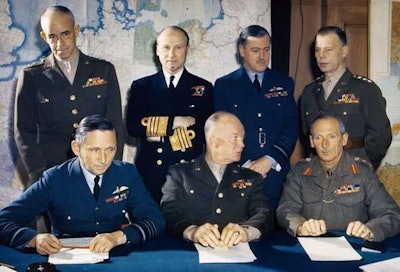 General Eisenhower, seated center, with his staff of Allied military leaders during WWII. Credit: History.com
General Eisenhower, seated center, with his staff of Allied military leaders during WWII. Credit: History.comReading how Ike formulated strategy and made decisions, you almost get the impression he had no opinions or thoughts of his own. Ike surrounded himself with the smart and capable men and then he let them hash it out as a group. He convened the discussions, he laid out the problem, and he kept his people focused. He was usually the smartest guy in the room, but most of all he listened.
In politics, where many military men stumble, Ike’s collaborative management style only got better, more personable and more successful.
3. Get your personality out of the way.
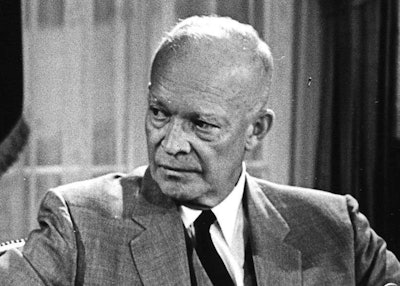
According to aides, in private Ike had a volcanic temper. He undoubtedly had a good size ego too. But in public, in meetings, in any official capacity, he was calm, even keeled and self-effacing. He wouldn’t suffer fools gladly, but he never engaged in drama, one-upmanship or shouting matches.
4. When you set a red line, make it stick.
 Eishenhower, center, with Martin Luther King Jr., left, and A. Phillip Randolph, right.
Eishenhower, center, with Martin Luther King Jr., left, and A. Phillip Randolph, right.Truman ordered the military to desegregate late in his presidency and nothing much happened, the military balked. Ike ordered it and six months later military desegregation was a done deal. When the governor of Arkansas refused a federal court order to desegregate that state’s schools in 1957, Ike gave him every opportunity to save face. But when he didn’t comply, Ike sent in the 101st Airborne—locked and loaded. He was not one to trifle with.
5. Cultivate good friends.
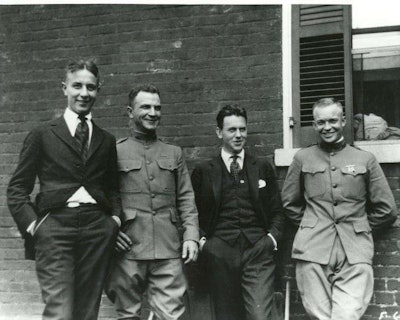 Eisenhower, far right, with three friends in 1919.
Eisenhower, far right, with three friends in 1919.For being a rawboned kid from a poor Kansas family Ike had an uncanny ability to figure out who mattered and who didn’t, who could help him and who would not. He was just one of a dozen or more capable generals when WWII broke out, but when the question was raised as to who would lead the Allies in Europe, the choice was quick and unanimous. Ike was the man. Even Churchill agreed.
After the war, Ike sought the friendship of business leaders. He started out with an occasional poker game and a small circle of influential men, a chance for all of them to blow off steam and escape from their pressure-cooker lives. But as Ike moved into politics he reached out more and more to his poker buddies for advice and support. The end result was that Eisenhower had more business people in his cabinet and a better economic record than any president since.
6. Know your role.
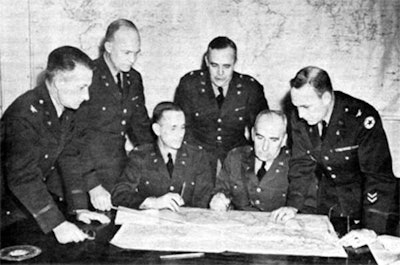 Eisenhower, standing second from left, during war planning in March of 1942.
Eisenhower, standing second from left, during war planning in March of 1942.Ike’s critics say that he never put himself in harm’s way, he never had that eye opening experience of having a bullet whiz buy his head. All true, but as much as Ike would have liked to command troops in battle, he knew his job was to manage the war, not fight it. His place was headquarters, not the field. He knew that a photo-op of him on the front lines was hardly worth the damage to morale and public opinion should he get killed or gravely injured in such a stunt.
7. Keep the common touch.
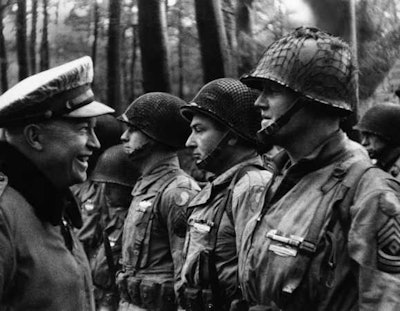
The GI’s loved Ike. The British public adored him, and he drew bigger crowds than any of their own generals when he spoke.
Late in the war Ike’s son John Eisenhower, graduated from West Point and was sent to the European theater. John wrote to his famous father before he arrived and asked if he had any advice. His dad’s reply was short and simple. As soon as you get here, Ike said, walk around and see what the sergeants and enlisted people are wearing. Then dress like they dress. In other words, if they wear cheap boots, you wear cheap boots.
The American public knew Ike was the real deal, a genuine man of the people, and he won the White House easily two times. His opponent Adlai Stevenson, was smart and capable, but by contrast came across as aloof and intellectual.
8. Don’t avoid emotionally difficult situations.
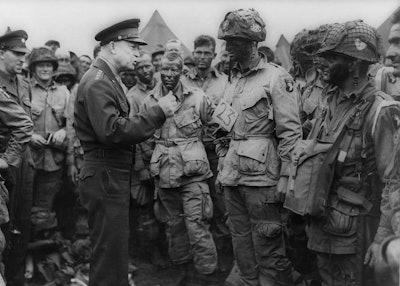
On the eve of D-Day, when the decision to go had been made, Ike and his generals had nothing more to do other than wait for morning. Rather that cool his heels, Ike drove out to where the airborne units were gearing up for their nighttime flight over the English Channel to parachute into Normandy. He wanted to visit one last time with the troops he was sending into harm’s way.
He didn’t line have anybody line them up in formation for inspection. He didn’t give a speech or make a show. He just walked from group to group and started talking, about football, about home, the sorry state of Army chow. Jokes were thrown, lightly. He shook hands, he looked them in the eye and wished them well knowing that half of them, some predictions said 70 percent, might never see home again.
9. Take responsibility.
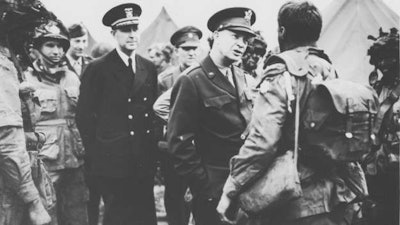
After he talked with the airborne troops that night, Ike went back to his quarters where he penned a speech that he would give, should the invasion fail, putting full blame for the failure on himself. A speech, thankfully, he never had to give.
10. Smile…a lot.
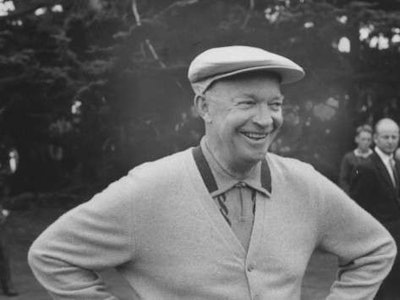
In the 1950s when American fears of Russian communism were being fanned to a fever pitch, Ike used his big grin, sunny disposition and all his powers of persuasion to court Russia’s leader Nikita Khrushchev. For six years he had Khrushchev eating out of his hand, and not until late in his presidency, when our U-2 spy plane was shot down over Russia, did Khrushchev break off the relationship.
A bit of a wild man
Contrary to the image most people have, Eisenhower in his youth was a bit of a wild man. On the West Point football team, Ike was, according to a colleague, “the first cadet on the field…and the very last to leave.” He was famous for his one armed chin-ups.
As a junior army officer during Prohibition he greatly enlarged his circle of friends with his ability to make bathtub gin. One of those admirers, a fellow officer (and home brewer as well) by the name of George Patton invited him along on his midnight rides in what was then a bandit plagued part of rural Maryland. Ike and Patton, after getting good and sloshed on their homemade hooch, would take off in Patton’s Pierce Arrow armed like vigilantes and drive slowly down these country roads trolling for would-be criminals to savage.
Saturday nights, his reputation as a wild man on the dance floor raised more than a few eyebrows. But no matter. Come Monday morning the young Captain Eisenhower was sober as a deacon and already two hours ahead of everybody else in his work.
Unlike a lot of wild and reckless types, Eisenhower showed great administrative ability and a subtle political sense. He knew who to court and who to flatter, how to solve problems that stumped lesser talents. He worked a thankless staff job for Douglas MacArthur in the Philippines for years as a favor to his superiors for the promise of greater command responsibilities down the road. Those opportunities opened up in WWII when Ike was picked to be the military leader of the Supreme Allied Command.
After the war the Democrats and Republicans both courted Ike to become their candidate for president in the 1952 elections. It is testimony to Ike’s ability to keep his cards close to his vest that neither party knew what his affiliation was until the day he did declare. Ike struggled with the far right wing of the Republican party, but his popularity with the people was such that the John Birchers and the anti-communist fringe never crossed him.
Upon assuming office, Ike took one look at the military stalemate in Korea and pulled the plug. When Britain and France asked the United States to join them in invading Egypt, Ike wisely told them to forget it. (That ill-advised military adventure ended in disaster for our former allies.)
In addition to being a military hero who left us with a clear warning about the military industrial complex, Eisenhower also set in motion the Interstate highway program, which paved the way for two decades of economic progress.
After the election of 1960, Kennedy’s glamor overshadowed Eisenhower’s legacy. The torch had been past, but the generation that received it has yet to live up the accomplishments of the old guard. We are only in just the past few years beginning to appreciate how rare and significant Eisenhower was. Jean Smith’s book is a major contribution to history and leadership studies and should be read by everyone who aspires to be a future leader or better leader.






